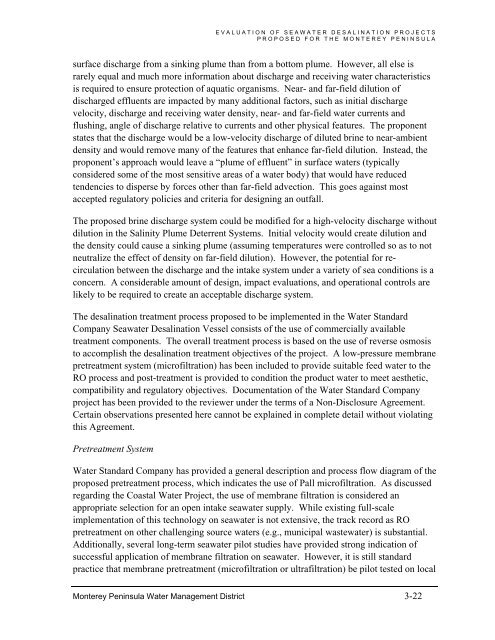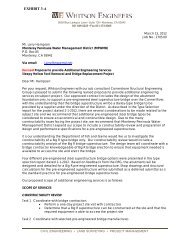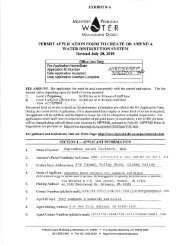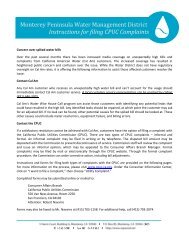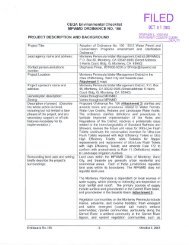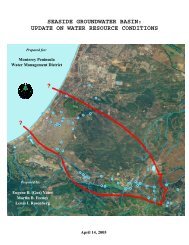FINAL REPORT Evaluation of Seawater Desalination Projects ...
FINAL REPORT Evaluation of Seawater Desalination Projects ...
FINAL REPORT Evaluation of Seawater Desalination Projects ...
You also want an ePaper? Increase the reach of your titles
YUMPU automatically turns print PDFs into web optimized ePapers that Google loves.
EVALUATION OF SEAWATER DESALINATION PROJECTS<br />
PROPOSED FOR THE MONTEREY PENINSULA<br />
surface discharge from a sinking plume than from a bottom plume. However, all else is<br />
rarely equal and much more information about discharge and receiving water characteristics<br />
is required to ensure protection <strong>of</strong> aquatic organisms. Near- and far-field dilution <strong>of</strong><br />
discharged effluents are impacted by many additional factors, such as initial discharge<br />
velocity, discharge and receiving water density, near- and far-field water currents and<br />
flushing, angle <strong>of</strong> discharge relative to currents and other physical features. The proponent<br />
states that the discharge would be a low-velocity discharge <strong>of</strong> diluted brine to near-ambient<br />
density and would remove many <strong>of</strong> the features that enhance far-field dilution. Instead, the<br />
proponent’s approach would leave a “plume <strong>of</strong> effluent” in surface waters (typically<br />
considered some <strong>of</strong> the most sensitive areas <strong>of</strong> a water body) that would have reduced<br />
tendencies to disperse by forces other than far-field advection. This goes against most<br />
accepted regulatory policies and criteria for designing an outfall.<br />
The proposed brine discharge system could be modified for a high-velocity discharge without<br />
dilution in the Salinity Plume Deterrent Systems. Initial velocity would create dilution and<br />
the density could cause a sinking plume (assuming temperatures were controlled so as to not<br />
neutralize the effect <strong>of</strong> density on far-field dilution). However, the potential for recirculation<br />
between the discharge and the intake system under a variety <strong>of</strong> sea conditions is a<br />
concern. A considerable amount <strong>of</strong> design, impact evaluations, and operational controls are<br />
likely to be required to create an acceptable discharge system.<br />
The desalination treatment process proposed to be implemented in the Water Standard<br />
Company <strong>Seawater</strong> <strong>Desalination</strong> Vessel consists <strong>of</strong> the use <strong>of</strong> commercially available<br />
treatment components. The overall treatment process is based on the use <strong>of</strong> reverse osmosis<br />
to accomplish the desalination treatment objectives <strong>of</strong> the project. A low-pressure membrane<br />
pretreatment system (micr<strong>of</strong>iltration) has been included to provide suitable feed water to the<br />
RO process and post-treatment is provided to condition the product water to meet aesthetic,<br />
compatibility and regulatory objectives. Documentation <strong>of</strong> the Water Standard Company<br />
project has been provided to the reviewer under the terms <strong>of</strong> a Non-Disclosure Agreement.<br />
Certain observations presented here cannot be explained in complete detail without violating<br />
this Agreement.<br />
Pretreatment System<br />
Water Standard Company has provided a general description and process flow diagram <strong>of</strong> the<br />
proposed pretreatment process, which indicates the use <strong>of</strong> Pall micr<strong>of</strong>iltration. As discussed<br />
regarding the Coastal Water Project, the use <strong>of</strong> membrane filtration is considered an<br />
appropriate selection for an open intake seawater supply. While existing full-scale<br />
implementation <strong>of</strong> this technology on seawater is not extensive, the track record as RO<br />
pretreatment on other challenging source waters (e.g., municipal wastewater) is substantial.<br />
Additionally, several long-term seawater pilot studies have provided strong indication <strong>of</strong><br />
successful application <strong>of</strong> membrane filtration on seawater. However, it is still standard<br />
practice that membrane pretreatment (micr<strong>of</strong>iltration or ultrafiltration) be pilot tested on local<br />
Monterey Peninsula Water Management District 3-22


